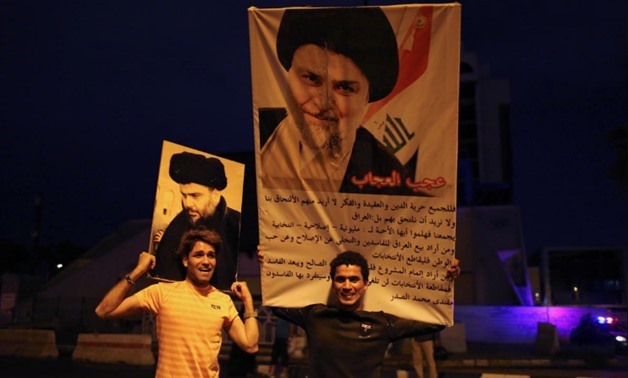
Supporters of Sairun list with portraits of Shi'ite cleric Moqtada al-Sadr, after results of Iraq's parliamentary election were announced in Baghdad May 14, 2018. REUTERS/Thaier al-Sudani
CAIRO – 14 May 2018: As the final votes from the 2018 parliamentary election are counted and confirmed, it appears that a surprise comeback has been made; what is transpiring to be a major blow to Prime Minister Haider al-Abadi’s reputation and campaign of secularism and inclusion, the popular populist cleric Muqtada al-Sadr has defied expectations and is leading the election.
Following a trend common across the election this year, turnout has been low at around 44 percent. If confirmed once the final election results are announced, this percentage will be overshadowed by Lebanon's parliamentary election on May 6, which saw 49.2 percent of the electorate head for the polls, and will trump the Egyptian presidential election in March of this year, which saw a turnout of 41 percent. The recent Tunisian municipal elections, also held on May 6, fared the worst, with a turnout of just 33.7 percent.
An inherent feature of elections is that there are winners and losers, and rise of Sadr’s Sairoon coalition to the forefront of Iraqi politics has come at the expense of the traditional Shiite elite in Iraq. He is expected to win 54 seats when the final votes are counted.
The 2018 election has been dominated by five Shia coalitions, most notably the Dawa Party, which has split between the Nasr coalition and the State of Law coalition, the Fatah coalition, Sairoon, and the Hikma coalition.
Sadr heads the Sadrist movement, an Iraqi Islamic national movement that draws wide support from across different branches of Iraqi society; however his policies of social reform have helped him find favour with the poorer classes in Iraqi society. When the protest movement broke out in July 2015, it gained significant momentum when it was joined by the Sadrist movement. Transpiring from anti-government protests, which initially focused on addressing poor living conditions, the protest movement demanded reform of the political system, and is an important factor behind Sadr rally of support.
His Sairoon coalition, under which 489 candidates stood in the parliamentary election, was born from the protest movement, and has stood on an anti-Iranian platform sharply different from that of his Shiite opponents.
Sadr commands the fearsome Saraya al-Salam militia, which gained notoriety as the Mahdi Army during the post-2003 insurgency in Iraq when it openly fought against U.S. forces. Saraya al-Salam exists as a competitor to Iranian proxies in Iraq, such as Asa'ib Ahl al-Haq and Kata'ib Hezbollah. Sadr refused to adhere to the calls from Tehran and Qom to send troops to support the Assad regime in Syria, and tensions have remained high. Sadr, along with Iraq’s highest religious cleric Ali al-Sistani, have been vocal in their concern over Iranian influence in Iraq.
In contrast stands Hadi al-Amiri. Amiri heads the Badr Organization, a powerful Shiite-dominated militia backed by Tehran, which has been essential to maintaining stability in Iraq and has a strong popular base amongst the majority Shiite community in Iraq. Amiri is closely allied with Iran, and there are fears that he would introduce sectarian policies, similar to those introduced under Maliki’s premiership, which proved to be destructive to Iraqi society.
Amiri initially formed an alliance with Abadi, but later they announced that they would run on separate ballots, with the possibility of forming an alliance after the elections, in order to form a government. Those close to Amiri fall under his Fatah coalition. Amiri’s coalition is expected to come second in the parliamentary election, with an estimated 47 seats.
The Nasr Coalition is led by incumbent, Abadi, who rose to the premiership in 2014, following the rapid territorial expansion of ISIS, the collapse of the Iraqi Army, and the lack of faith in then Prime Minster Nouri al-Maliki. In the knowledge that he would fail to attract the support of the staunchly Shiite south, which would likely sway towards the Iranian facing Amiri and Maliki, Abadi conducted a campaign which took him around the country in order to establish a secular support base.
Notably, he travelled to the Sunni region of Anbar to open a party headquarters, in the hope of winning the Sunni vote after the Iraq army’s successes against ISIS. He also opened a campaign office in Sulaimaniyah, which he visited on April 26 to attend the Nasr coalition conference. He also toured Erbil and Kirkuk in Kurdistan in a bid for support. Unheard of for a Shiite candidate in Iraq, who tends to stick to campaigning in the south, Abadi wasn’t able to attract enough support. His Nasr coalition will finish third, with an expected 42 seats.
Sadr will not become prime minister as he did not run in the election; however his likely victory will put him in a position of power during the negotiation process which will follow the official results. Candidates who aspire to take the helm of the fragile and fragmented Iraqi Parliament will have to play a tough balancing act. Sadr portrays himself as an Iraqi nationalist and is weary of Iranian support, thus he will be cautious of prompting a pro-Iranian figure. There are many other factors at play however, including that of powerful Sunni and Kurdish coalitions.


Comments
Leave a Comment